Fixing a Leaking Flexible Hose Under a Sink Quickly
Author: Omar Alonso | Editor: Omar Alonso
Review & Research: Jen Worst & Chris Miller
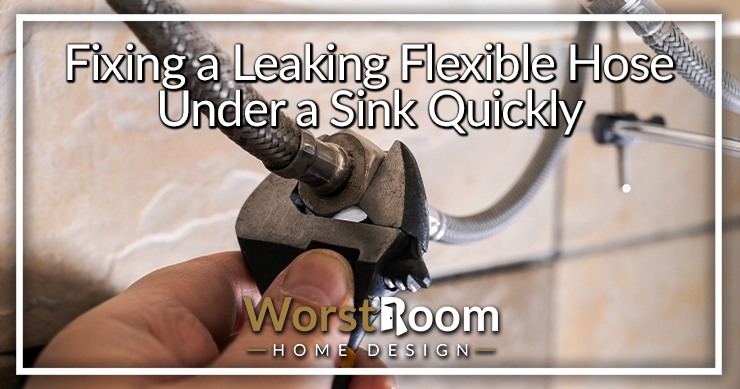
You stand at the sink, brushing your teeth, ready for bed. Suddenly, you notice your feet feel wet. You haven't showered or bathed, so why is there water on the floor? Peering under the sink, you see the water delivery hose to the faucet is dripping. How do you fix a leaking flexible hose under a sink? It's fairly straightforward if you have the right tools and some basic plumbing experience.
What Are Plumbing Flexi Hoses?
A flexible or Flexi hose is the name for the water delivery pipe coming out of the wall water valve and connecting to the faucet on the sink. While common in most types of bathroom sinks, you'll find them under most sinks throughout the home. It's a common plumbing hose and, unfortunately, prone to experiencing leaks.
Flexi hoses feature design and construction with stainless steel braiding wrapping a rubber core, making them highly flexible. These hoses are useful for bending around corners, especially under sinks and toilets. Using standard fixed PVC for this task isn't possible unless you want to spend hours on joint work, though even insulated PEX pipe is flexible.
Flexi hoses are cheap and readily available for plumbing stores, with standard connections to fit faucets and toilets. These hoses aren't rocket science to install; you can do it yourself. But hiring a plumber for the job eliminates the risk of something going wrong with the installation.
A Flexi hose comes with a service life of around five years. You don't need to repair them if they start to leak; they are cheap enough to replace.
Problems a Leaking Flexi Hose Can Cause in the Home
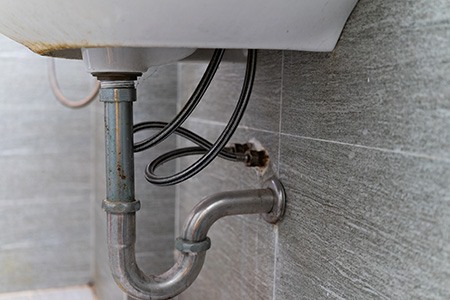
While flexi hoses are useful and have plenty of plumbing applications, they're also notorious for leaking. A leaking flexible hose under sinks is common and nothing to stress about. As long as you can access the hose, you should experience any issues with replacing it.
When a flexible hose starts leaking, it can cause water damage to porous materials, like bathroom cabinets. In most cases, it won't have a huge leak, more of a drip, so the risk of flooding your home is minimal. Since they're usually installed in bathrooms and kitchens, they typically aren't around appliances where water can damage electrical equipment.
That said, you'll need to replace the hose, or the dripping will eventually cause water damage. As you know, drips don't improve; they become bigger leaks. Replacing the hose when you notice the leak is always the best option to prevent it from becoming a bigger problem.
Why the Faucet Hose is Leaking Under the Sink
The braiding in flexi hoses frays over time. The most common dysfunction for these hoses is when they're positioned in tight spaces under sinks and other pipes rub against them. Or when certain types of faucets get slightly loose, and the hose starts to twist, compromising the structural design of the hose and causing the braiding to fray.
The most common cause of flexi hoses prematurely failing is poor quality construction from manufacturers and improper installation by homeowners or plumbers. When you investigate your leaking flexible hose under the sink, check around the fittings or clamps to see if the hose has ruptured near the connection.
Poor quality hoses can see rust develop on the braiding and fittings, and under-tightening the fitting, usually under the faucet, is another common issue causing failure of the flexi hose. If for some odd reason here you're using a SharkBite fitting, it could be the SharkBite fitting leaking, too, so check on that.
Is a Leaking Hose Under the Sink a Big Problem?
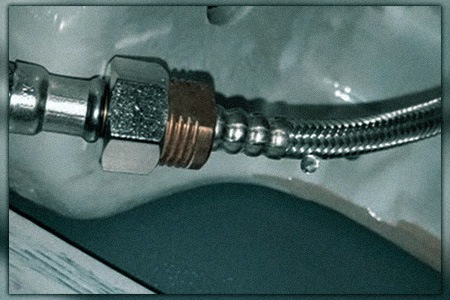
In general, when flexi hoses start leaking, they cause minor drips at first. You don't really have to worry about them splitting wide open and flooding the floor and surrounding area. However, they require immediate replacement when you first notice the leak.
Like all plumbing fittings, it will only worsen if you don't attend to the problem right away, leading to bigger problems. If the hose isn't replaced, it might split, and the pressurized water from the delivery valve under the sink bursts through the hose, causing flooding. As mentioned, you'll usually get an advanced warning this event is on the horizon when the hose starts leaking.
How Do You Fix a Leaking Flexible Hose Under a Sink?
The first thing to do is assess the situation. There could be two things wrong with the hose. First, it might have a loose connection to the water delivery valve or, more commonly, the sink faucet. If you notice water dripping from either of these connections, you can try to tighten the fitting and see if it stops the leak.
The second common reason flexi hoses fail is a braiding breach surrounding the inner rubber tubing. Flexi hoses are flexible, but twisting the braids can cause them to fray and split.
If you have loose faucets or taps, it can cause the hose to twist under the sink. The twisting action stresses the braids, causing them to fray, resulting in the splitting of the rubber tube as it can't handle the water pressure and stress on the tube.
How to Replace a Flexible Hose Under a Sink
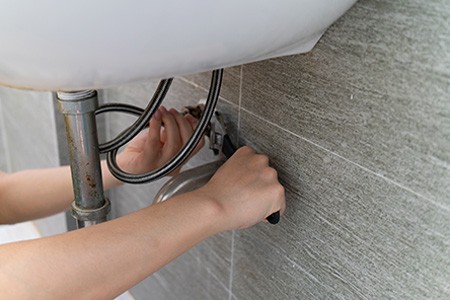
If tightening the fittings doesn't fix the problem and the hose keeps leaking, you'll need to replace it. Fortunately, that's an easy DIY job, provided you have the right tools and some basic plumbing experience.
Start by turning off the delivery valve coming from the wall. You'll notice the valve has a plastic fitting at the top of the valve you can grip with your fingertips. Turn it until the line face perpendicular to the pipe. This action closes the valve and stops the water.
Next, place a towel on the floor below the delivery valve and grab a bucket. When you disconnect the homes from the valve using your wrench, the hose will leak water. Capture it in the bucket and pour it down the sink.
The tricky part is removing the hose under the faucet end of the line. Sometimes, these hoses connect in tight spaces, and it might be challenging to grab the nut at the base of the fitting. It depends on the sink design, but most are easy to remove.
You'll have to grip the faucet as you turn the nut to prevent it from twisting. After removing the flexi hose, inspect the valve and faucet threads. They should be clean and undamaged. Remove any hemp braid or plumbers tape from the thread and ensure there's no debris on the threads.
Next, connect the new hose to the faucet end first. There's a rubber gasket in the faucet, so there's no need to use plumbers' tape on this end to prevent the connection from leaking. Wrap the delivery valve threads with plumbers' tape.
Give it around five winds or so until the threads look like little bumps. The plumber's tape forms a watertight seal between the hose fitting and the valve. If you don't tape it, you'll get a leak. If you're having a dripping leak and nothing drastic, and it's coming from the fitting itself, this is likely why. Teflon tape will save the day.
Finish the job by screwing on the fitting at the end of the flexi hose to the delivery valve. Ensure the braided line doesn't twist while winding on the nut. After it's hand-tight, fasten it securely to the valve using your wrench. Turn the water back on and open the faucet. Inspect the fittings at both ends for leaks. No more leaking flexible hose under the sink!
FAQs for Leaking Flexible Hoses Under a Sink
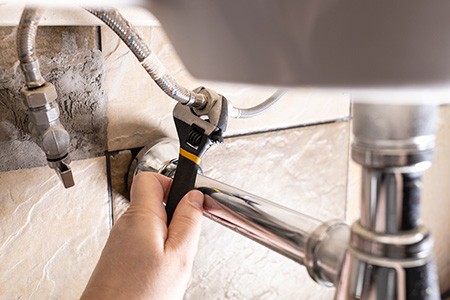
When the topic of a flexible sink hose leaking under the sink comes up there’s always a handful of other questions that arise. Let’s take care of those now.
What Are the Disadvantages of Installing Flexible Hoses?
Flexi hoses are cheap to manufacture. As a result, there's a bit of a problem with the quality in the industry. Some hoses last longer than others, and it's challenging to find brands that offer the best durability because they're all mass manufactured in China.
It's better to order the hose from a plumbing store than online. The plumbing store will likely have a reputable supplier, whereas online suppliers can sell you anything.
How Often Should Flexible Hoses Be Replaced?
The general rule of thumb is to replace the flex hose every five years. However, these hoses don't usually cause catastrophic leaks that cause flooding; they typically start dripping. So, they don't really require preventative maintenance. However, you should replace them promptly when you notice any leaks.
How Do You Seal a Leaking Sink Hose?
If the hose fittings leak after installing the new flexi hose, it's because you don't have enough plumbers tape sealing the fitting. It's common for this to occur at the water delivery valve. Remove the fitting and add more plumbers tape to the threads, then refit and check if it continues leaking. If it does, you might have a faulty hose.
Key Takeaways for Leaking Flexible Hoses Under Sinks
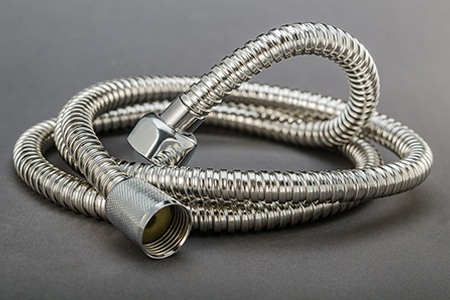
- Flexi hoses allow you to connect the water delivery valve to the faucet.
- The hose is flexible, allowing it to wind around obstacles under the sink, preventing the need for copper or PVC pipes and joints.
- The average lifespan for a flexi hose is five years, and you'll need to replace it when it fails.
- These hoses are affordable, so replace them, don't try and fix them.
- The most common failure points for flexi hoses are at the fittings at the end of the hoses, usually under the faucet connection. Or the braided line might twist, causing it to fray and leak.
- Usually, you'll have enough time to replace the flexi hose when you first notice the drips to prevent catastrophic line damage that causes flooding.
- Most homeowners can replace a leaking flexi hose without calling a plumber, provided they have the right tools and basic plumbing knowledge.
That’s How to Fix a Leak in a Flexible Hose
If your water supply line is leaking under the sink, that’s something you’ll want to take care of pretty quickly so you don’t sustain damage to the flooring or particle board cabinetry under the sink. A leaking flexible hose under a sink is thankfully an easy fix using our procedure above.



